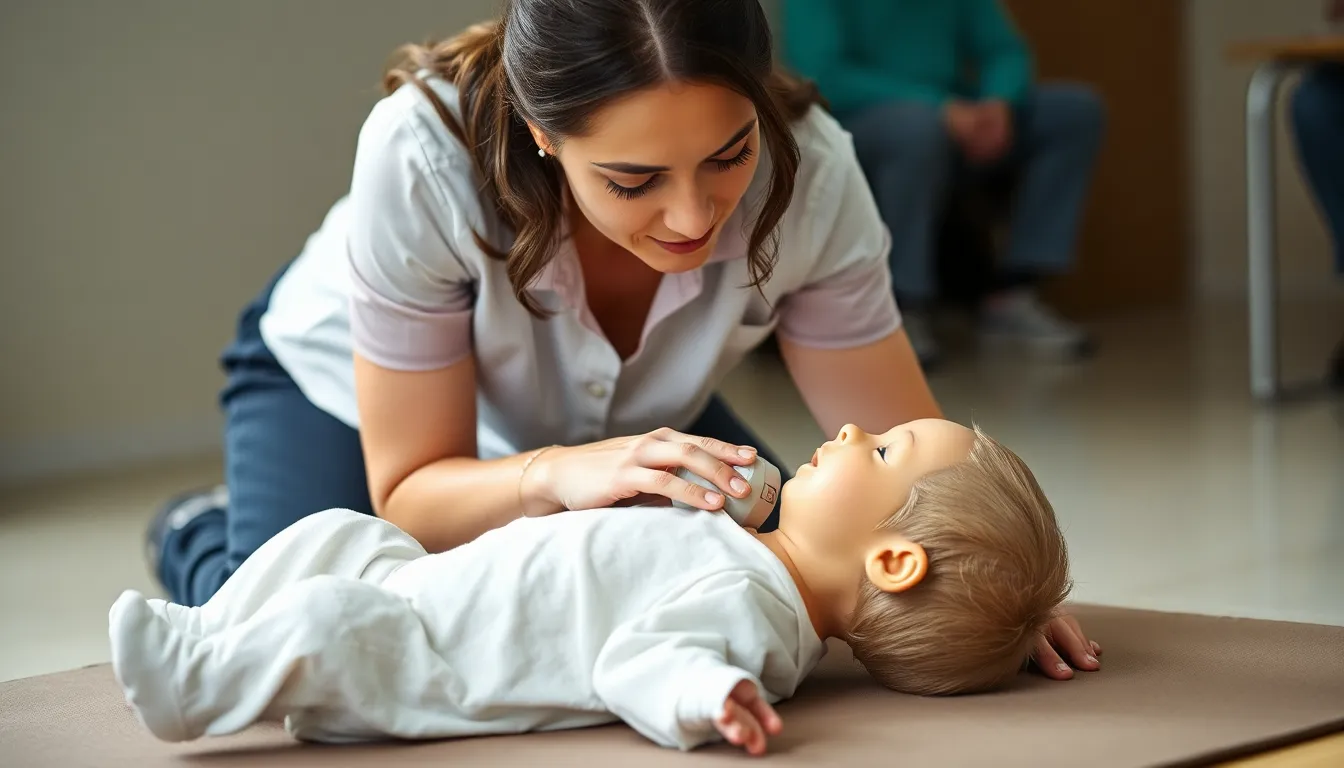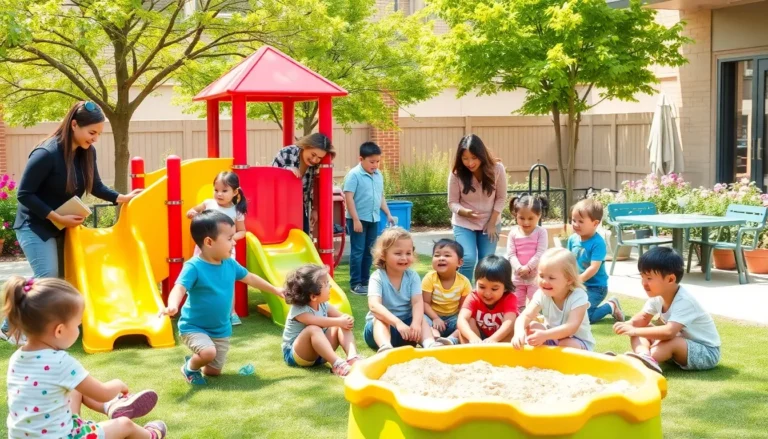When it comes to child CPR, understanding the correct rescue breath rate is crucial. In emergencies, every second counts, and knowing how to provide effective breaths can make a life-saving difference. Parents, caregivers, and anyone involved in child care should be prepared with the right techniques to ensure a child’s safety.
The rescue breath rate for children differs from adults, making it essential to grasp these specific guidelines. By familiarizing themselves with the appropriate rates and methods, caregivers can respond confidently in critical situations. This knowledge not only empowers individuals but also enhances the chances of a positive outcome when every moment matters.
Table of Contents
ToggleUnderstanding Rescue Breath Rate For Child
The rescue breath rate for children differs significantly from adults. For child CPR, the appropriate rate is 12 to 20 breaths per minute. This equates to one breath every 3 to 5 seconds. Caregivers must maintain this rhythm during resuscitation to provide effective oxygenation.
In emergencies, the size and age of the child dictate the breath method. For infants, deliver gentle breaths with a shorter duration, ensuring the chest rises visibly. For children aged 1 to 8, apply an appropriate breath volume and frequency, while ensuring not to overinflate the lungs.
Table 1 illustrates the variations in rescue breath rates based on age groups:
| Age Group | Rescue Breath Rate (per minute) | Breaths per Second |
|---|---|---|
| Infants (0-1 year) | 20 to 30 | 1 every 2-3 seconds |
| Children (1-8 years) | 12 to 20 | 1 every 3-5 seconds |
| Older Children (8+) | 12 to 20 | 1 every 3-5 seconds |
Proper technique enhances the effectiveness of rescue breaths. Caregivers must ensure a good seal around the mouth and nose for infants. For older children, tilt the head slightly to maximize airway patency. Familiarity with these guidelines enhances confidence in emergency situations, leading to improved outcomes.
Importance Of Correct Rescue Breath Rate

Understanding the correct rescue breath rate is essential for effective child CPR. Accurate breaths can significantly increase a child’s chance of survival during emergencies.
Benefits Of Accurate Rescue Breaths
- Increased Survival Rates: Providing rescue breaths within the recommended rate of 12 to 20 breaths per minute can enhance oxygen delivery, vital for sustaining life.
- Reduced Risk of Brain Damage: Timely and effective rescue breaths minimize the risk of hypoxia, helping to protect the brain from potential damage caused by lack of oxygen.
- Improved Circulation: Proper breath patterns support cardiovascular function by maintaining adequate oxygen levels, facilitating better blood flow to vital organs.
- Boosted Confidence Among Responders: Familiarity with correct techniques empowers parents and caregivers, allowing them to provide immediate and effective assistance in emergencies.
Impact On Child’s Safety
- Greater Chance of Recovery: Correctly performed rescue breaths improve the likelihood of restoring normal breathing patterns, enhancing overall recovery prospects.
- Prevention of Further Complications: Accurate breaths lower the risks of complications related to ineffective resuscitation efforts, safeguarding against additional health issues.
- Encouragement of Prompt Action: Knowledge of specific breath rates encourages rapid intervention, making a difference in critical situations where every second counts.
- Enhanced Community Preparedness: Awareness of proper rescue breath techniques within the community fosters a culture of readiness, ensuring more individuals can assist in emergencies.
Recommended Rescue Breath Rates
Understanding the correct rescue breath rates for children is essential for effective CPR. Following age-specific guidelines and making necessary adjustments for special conditions ensures optimal outcomes in emergencies.
Age-Specific Guidelines
- Infants (0-1 year): Deliver 20 to 30 breaths per minute, or one breath every 2 to 3 seconds. Use gentle breaths while maintaining a good seal around the mouth and nose.
- Children (1-8 years): Administer 12 to 20 breaths per minute, or one breath every 3 to 5 seconds. Ensure the head is slightly tilted to enhance airway flow and use an appropriate volume.
- Older Children (over 8 years): Follow adult guidelines with a rescue breath rate of 10 to 12 breaths per minute. Prioritize a full head tilt to open the airway effectively.
Adjustments For Special Conditions
- Respiratory Issues: Increase breath volume for children with pre-existing respiratory conditions, keeping an eye on their comfort and response.
- Obesity: For overweight children, consider a modified approach; delivering breaths may require more force to ensure air reaches the lungs.
- Improper Seal: If a good seal isn’t possible, reposition the child to improve alignment and aid in delivery.
Understanding these specifics helps caregivers perform rescue breaths effectively, ultimately increasing survival chances during emergencies.
Techniques For Administering Rescue Breaths
Administering rescue breaths correctly requires precise techniques tailored to a child’s age and condition. Understanding the various positioning and breathing methods ensures effective intervention during emergencies.
Positioning The Child
Positioning the child properly is critical to maximizing the effectiveness of rescue breaths.
- For infants (0-1 year), lay the baby on their back on a firm, flat surface. Keep the child’s head in a neutral position.
- For children (1-8 years), place them flat on their back, ensuring the head is slightly tilted backward. This position opens the airway while preventing obstruction.
- For older children (over 8 years), place the child on their back with the same head tilt. This aids in securing an open airway for rescue breaths.
- Avoid excessive head tilting to prevent airway blockage, particularly in children with underlying respiratory conditions.
Effective Breathing Techniques
Using effective breathing techniques improves the chances of successful rescue.
- For infants, cover the mouth and nose with the responder’s mouth to create a seal, delivering gentle breaths. Each breath should last about 1 second, providing enough volume to see the chest rise.
- For children, the responder should pinch the child’s nose shut, cover the mouth entirely, and deliver breaths that are more forceful than those for infants. Each breath should also last about 1 second with a visible rise of the chest.
- Adjust the rate depending on age: deliver 20 to 30 breaths per minute for infants and 12 to 20 breaths per minute for children aged 1 to 8. For older children, align with the adult rescue breath rate of 10 to 12 breaths per minute.
- Monitor the effectiveness of breaths by checking for visible chest rise and ensuring that breaths are not delivered too rapidly, which can lead to complications like air entering the stomach.
Adhering to these guidelines enhances the likelihood of successful rescue efforts and can significantly impact a child’s chances of recovery.
Common Mistakes To Avoid
Understanding common mistakes during rescue breaths can improve effectiveness and safety. Awareness of these errors helps caregivers perform CPR accurately.
Misjudging The Breath Rate
Misjudging the breath rate can significantly impact a child’s chance of survival. Delivering breaths too quickly or too slowly decreases effectiveness. For infants, the rate should be 20 to 30 breaths per minute, while for children aged 1 to 8, it should be 12 to 20 breaths per minute. Adhering to these specific rates ensures that oxygen reaches vital organs appropriately. Failing to maintain the correct timing can lead to inadequate oxygenation or hyperventilation, both of which can compromise recovery.
Neglecting Child’s Response
Neglecting to monitor a child’s response during rescue breaths can hinder effective CPR. Caregivers must observe for signs of improvement, such as a visible rise in the chest, and adjust technique if necessary. If rescue breaths don’t result in chest movement, reevaluating the airway position or seal is crucial. An unresponsive or unchanging condition may signal the need for alternative interventions. Ignoring the child’s response can delay essential actions and reduce the likelihood of a successful outcome.
Mastering the rescue breath rate for children is vital for effective CPR. Knowing the specific rates for different age groups empowers caregivers to act decisively in emergencies. Proper technique and positioning enhance the chances of survival and recovery.
By staying informed and practicing these guidelines, parents and caregivers can significantly impact a child’s outcome in critical situations. Awareness and preparedness can make all the difference when every second counts.




